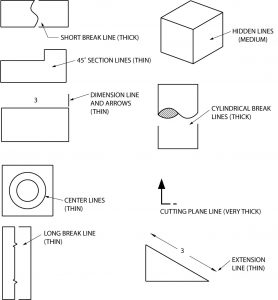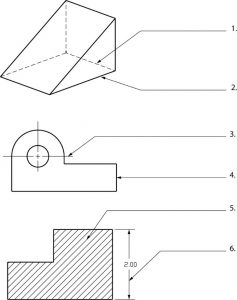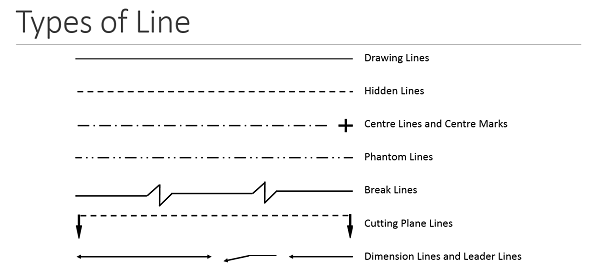All other lines contrast with the visible lines by having either a thinner weight. Figure 23 - Dimensioned Drawing.

The Language Of Lines Basic Blueprint Reading
Object lines are solid heavy lines 7 mm to 9 mm.

. DIMENSION LINE Thin and dark lines use to show the size span of an object with a numeric value. Isometric projection is a method for visually representing three-dimensional objects in two dimensions in technical and engineering drawings. There are various options available making it possible to show hidden and visible edges of parts.
Although THICK lines of Type-E are recommended for representing the hidden edges THIN lines of Type-F are preferred. Hold the pencil naturally. A visible line or object line is a thick continuous line used to outline the visible edges or contours of.
In such projection the projectors are not perpendicular to the plane of projection rather inclined to the plane of projection at 30 45 or 60. Note all the lines you find on an engineering drawing are equal. Therefore any surface that is not in line with the three major axis needs its own projection plane to show the features correctly.
The dimension line is a thin line broken in the middle to allow the placement of the dimension value with arrowheads at each end figure 23. Drawing is the standard used in engineering and technology because many times the other three principal views are mirror images and do not add to the knowledge about the object. Lets discuss a few of the most important types.
Many other line types exist and are used to communicate things like interior detail but object lines are the darkest lines on the pagescreen. These lines are used for the main lengths of the object view. Basic Types of Lines Used in Engineering Drawings By Kelly Curran Glenn Sokolowski.
Object lines stand out on the drawing and clearly define the outline and features of the object. Engineers compare with the task of communicating machine design development and structures to manufacturers and manufacturers. In this highly interactive object learners associate basic line types and terms with engineering drawing geometry.
Imagine sketching the front view of a house. These lines define the shape of the object portrayed and are the outermost outline of the object. A round bar is shown as a circle in one view and a rectangle in the other.
Engineering Working Drawings Basics Page 8 of 22 parallel to the object surface. Object line Figure 3 Object lines Hidden lines. Be used for most purposes on engineering drawings.
Thin line with arrows. The first dimension line. 2 The Language of Lines Object Line.
Thin hidden lines are used as intermittent line types. 5 Side Views When the observer looks at the object from side ie from his left-hand side or right-hand side the view. A hidden line also known as a hidden object line is a medium weight line made of short dashes about.
An extension line extends a line on the object to the dimension line. Line weight is the thickness of the line. A line representing changes of pressure or temperature under conditions of constant volume.
The shape and size of the various parts of the machine and its structure must be recorded on flat plates in a systematic way for. Object lines are used in hand drawing and CAD to define the edges of the view being drawn. 4 When the observer looks at the object from above the view obtained is called top view TV or plan.
Used to indicate visible object of an object. A line such as a contour line drawn on a map and indicating a true constant value throughout its extent. This line is used to represent the center line for circles and arcs.
An arrowhead is approximately 3 mm long and 1 mm wide. Draw the line firmly with a free and easy wrist-and-arm motion. Definition of isometric line.
OBJECT OR VISIBLE LINES Thick dark line use to show outline of object visible edges and surfaces. Construction lines and guide lines are very light easily erased lines used to block in the main layout. Both would be drawn with object lines.
Used to indicate hidden edges corners hidden in a particular view. That is it is a type of line used. These thick solid lines show the visible edges corners and surfaces of a part.
In general application thick lines are 06 mm024. Detail Views A detail view is a separate large-scale drawing view of a small section of another view. TV is seen on the HP.
Hidden Lines Thin type lines consist of thin short dashes closely and evenly spaced. Linetypes And Weight Standards In Technical Drawing. A visible line sometimes called object line is used to show the edges of an object that are visible to the viewer.
Many people refer to this as a drawing line. This line is used to show hidden edges of the main object. Spot the beginning and end points.
Centre lines Lines of Symmetry Trajectories and Pitch Circles. This line is used to represent the location of a cutting plane. Visible lines are the edges or outlines of an object.
This line is located in front of cutting planes outlines of adjacent parts censorial Lines and to state center of gravity. Object line in engineering drawing What are the symbols used in engineering drawing. These lines are drawn to represent hidden or invisible edges of the objects.
CONSTRUCTION LINE Very light and thin line use to construct layout work. The standard views used in a three-view drawing are the top front and the right side views. The actual type of material required is then noted in the title block or parts list or as a note on the drawing.
A quiz completes the activity. Thin lines are nearly 03 mm012 in most technical drawings. In oblique projection the object is aligned such that one face front face is parallel to the projection plane.
Thick and visible line. Shows many of the different types of lines that are used in drawings. That is the length is roughly three times the width.
Here oblique axis is called as receding axis. Swing the pencil back and forth between the points barely touching the paper until the direction is clearly established. The angle at which lines are drawn is usually 45 degrees to the horizontal but this can.
Object lines Object lines Figure 3 are the most common lines used in drawings. The most common type of line is the continuous line. Used to extend the edge face or corner of a geometric feature.
You can see that each line has a specific meaning you must understand to interpret a drawing correctly. It is an axonometric projection in which the three coordinate axes appear equally foreshortened and the angle between any two of. Usually terminates with arrowheads or tick markings.
It represents an objects physical boundaries. They are drawn as solid lines with a thickheavy weight.
What Is The Purpose Of Using Hatching Lines In Engineering Graphics Drawing Quora

The Language Of Lines Basic Blueprint Reading
Line Conventions Manufacturinget Org

Engineering Drawing Notes B Drawings Engineering Types Of Drawing

How To Read Engineering Drawings A Simple Guide Make Uk

Engineering Design And Cad A B Line Types Flashcards Practice Test Quizlet

What Are Lines Types Of Lines In Engineering Drawing Youtube

0 comments
Post a Comment